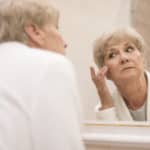
Current melanoma incidence in older white men (65 and older) is about five times that of the general population.
Before age 50, the incidence of melanoma in women is higher than men, but by age 65, melanoma incidence rates are twice as high in men. By ages 80 and older, the rate is three times higher in men than women of the same age.
Why are older men highly susceptible to melanoma? Over a lifetime, men spend more time outdoors accumulating ultraviolet exposure and are less diligent about wearing sun protection. They also might be less likely to perform skin self-exams and have physician check-ups. Also, research shows that melanoma might advance differently in men than women and that men’s tumors might grow more rapidly.
Prevention through early detection of melanoma is especially important in reducing mortality in high-risk groups – older men being the largest high-risk group of all. Part of the reason for the high mortality rate is the difficulty in distinguishing benign skin moles from malignant melanomas.
Ranjan Perera, Ph.D., associate professor at Sanford Burnham Prebys Medical Discovery Institute at Lake Nona, pinpoints the problem: “Current tests are inconclusive at least 15 percent of the time, requiring repeated biopsies.” His lab is researching new biomarkers that could provide clinicians with earlier and more reliable diagnostics for melanoma. His approach focuses on micro-RNAs (non-protein coding genetic material) that might contribute to the formation and progression of melanoma.
Research suggests that the majority of melanomas – nearly 90 percent – are considered to be preventable, so following guidelines to limit exposure to damaging UV (ultraviolet) sunlight is the first line of defense. Severe sunburns, especially during childhood, increase your risk of developing melanoma and other skin cancer. Just one blistering sunburn can double your chances of developing melanoma later in life.
Perera and collaborator Michael Steppie, M.D., assistant professor of dermatology at Florida State University, are investigating various skin disorders. Dr. Steppie, a noted Florida dermatologist, offers these sun safety suggestions for people who live in warm weather regions.
Follow these tips to reduce your risk of developing melanoma:
- Remember that all skin types can develop skin cancer, including people who tan easily or have naturally dark skin.
- Generously apply sunscreen to all exposed skin – even on cloudy days – year-round.
- Use a sunscreen that provides broad spectrum protection from both UVA and UVB rays and has a sun protection factor (SPF) of at least 30.
- Apply approximately one ounce of sunscreen (a shot-glassful) 15 minutes before sun exposure.
- Reapply sunscreen every two hours and after swimming or sweating.
- Keep newborns out of the sun. Sunscreens should be used on babies over the age of six months.
- Wear a long-sleeved shirt, pants, a wide-brimmed hat (preferably sun-protective clothing, accessories and swimwear carrying a UPF 50+ label), and UV-blocking sunglasses.
- Seek shade when possible. The sun’s rays are the strongest between 10 a.m. and 4 p.m.
- Water, snow and sand reflect and magnify the damaging rays of the sun, increasing your chance of sunburn. Especially during peak hours while at the beach, stay in the shade from an umbrella carrying a UPF 50+.
- Avoid tanning beds – there is no way to get a tan through UV exposure without increasing the risk for skin cancer. Using a tanning bed before age 35 increases your risk for melanoma by 75 percent.
- Be aware that certain prescription medications and over-the-counter drugs can increase your skin’s sensitivity to sunlight.
- Sun-proof your car windows with UVA-filtering window glass or film.
Source: Melanoma Research Foundation, American Academy of Dermatology.
About SBP
Sanford Burnham Prebys Medical Discovery Institute (SBP) is an independent, nonprofit medical research organization that conducts world-class, collaborative, biological research and translates its discoveries for the benefit of patients. SBP focuses its research on cancer, immunity, neurodegeneration, metabolic disorders and rare children’s diseases. The institute invests in talent, technology and partnerships to accelerate the translation of laboratory discoveries that will have the greatest impact on patients. Recognized for its world-class NCI-designated Cancer Center and the Conrad Prebys Center for Chemical Genomics, SBP employs about 1,100 scientists and staff in San Diego (La Jolla), Calif., and Orlando (Lake Nona), Fla. For more information, visit us at SBPdiscovery.org, on Facebook at facebook.com/SBPdiscovery, and on Twitter @SBPdiscovery.



